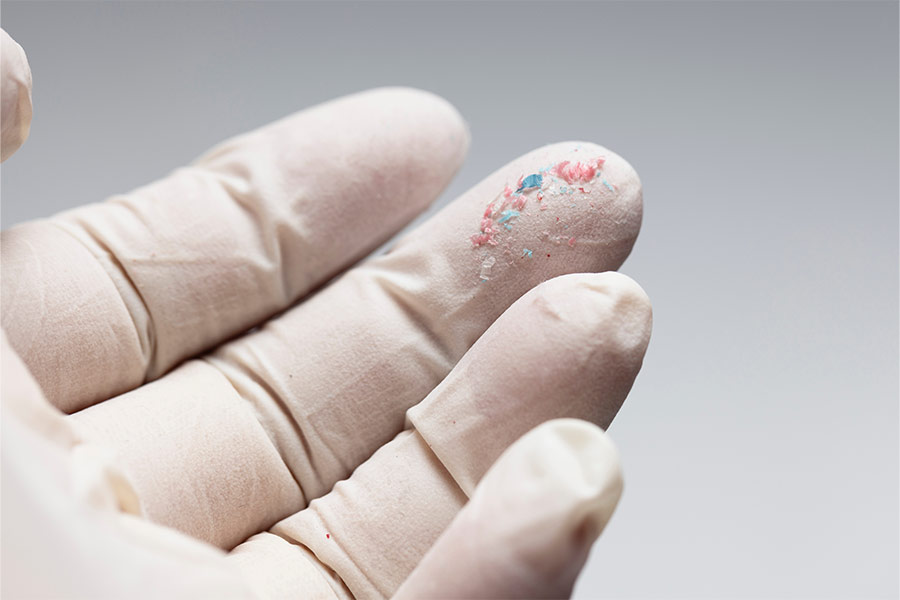
A Growing Crisis: The Ubiquity of Microplastics
More than 460 million metric tons of plastics are produced annually, and nearly all of it eventually degrades into microplastics (< 5 mm) and nanoplastics (< 1 µm) through external processes like friction and ultraviolet light exposure. These tiny particles, along with plastic-derived chemicals, are nearly ubiquitous; found in oceans, soil, food, drinking water, and even the human body.
Microplastics in Personal Care Products
Microplastics are commonly incorporated into cosmetics and personal care products to enhance their texture and functionality. Some of their uses include:
- Microbeads: Tiny, spherical microplastics added to face scrubs, body washes, and toothpaste for exfoliation and deep cleaning.
- Thickening agents: Used to improve the consistency and spreadability of lotions, creams, and gels.
- Film-forming agents: Synthetic polymers provide water resistance in sunscreens, lotions, and hair sprays.
- Cosmetic enhancers: Microplastics enhance the skins appearance with a pearlescent or opaque finish.
Currently, more than 500 microplastic ingredients are used in cosmetics and personal care items, with polyethylene and acrylates copolymer being the most common.
Alarming Discovery: Microplastics Found in Human Organs
A recent study, using a novel research method combining gas chromatography mass spectrometry (GC-MS) and light microscopy, revealed widespread microplastic accumulation in human organs. Tissue samples collected from biobanks across the U.S. confirmed the presence of microplastics in:
- Kidneys
- Liver
- Brain
It has also been linked to:
- Lungs
- Placenta
- Breast milk
- Lipid plaques in carotid arteries (which are linked to cardiovascular disease)
Microplastics in the Brain: A Disturbing Trend
One of the most concerning findings was the drastic increase in nano- and microplastics in the brain. Between 2016 and 2024, individuals who died in 2024 had significantly higher concentrations of microplastics in their brains compared to those in 2016.
The frontal cortex, an essential region for cognition and decision-making, contained approximately 4,000 micrograms per gram of brain tissue. Given that this area weighs about 500 grams, researchers estimate that there could be around 2 grams of plastic embedded in this brain region alone.
Dementia and Microplastics: A Possible Connection?
A subset of individuals in the study had dementia at the time of death, and their brains contained five to ten times higher plastic levels (ranging from 20,000 to 50,000 micrograms per gram of brain tissue). While there is no definitive link between microplastics and dementia, researchers speculate that:
- Microplastics may contribute to neurological decline, or
- People with dementia may accumulate more microplastics due to a weakened blood-brain barrier (which normally protects the brain from harmful substances).
Microplastics and Human Health
Entry Points: How Microplastics Get into the Body
Microplastics don’t just harm the environment—they can enter the human body through multiple pathways:
- Skin (via personal care products and textiles)
- Lungs (through inhalation of airborne microplastics)
- Gut (from food, water, and packaging)
- Placenta (passing from mother to foetus)
Their presence in breast milk and the placenta means that babies are exposed even before birth.
Solutions and Prevention
Reducing Plastic Waste
Governments, industries, and individuals must take steps to reduce plastic production and consumption. Banning single-use plastics, promoting biodegradable alternatives, and implementing recycling initiatives are essential strategies.
Improved Waste Management
Proper disposal and recycling of plastic waste can prevent microplastic pollution. Enhanced filtration systems in wastewater treatment plants can also help remove these particles before they enter the environment.
Avoiding Microplastics in Personal Care
Consumers can reduce exposure by choosing:
- Microplastic-free skincare and cosmetics
- Natural fibres instead of synthetic clothing
- Reusable and plastic-free alternatives for food storage and daily use
Raising Awareness
Educating the public about the dangers of microplastics is crucial in driving change. Transparency in labelling and stricter regulations on microplastic use in consumer products are necessary to protect public health.
Conclusion
Microplastics are no longer just an environmental issue; they are a public health crisis. Their presence in human organs, including the brain, is alarming and raises urgent questions about long-term health effects. While there is still much to learn, the sharp increase in microplastics in recent years suggests we are only beginning to understand their full impact.
The failure to prevent this can be attributed to three key factors: lack of awareness, resulting in weak public health policies; insufficient regulations, which fail to comprehensively address plastic pollution; and gaps in scientific research, limiting our understanding of long-term health impacts. Current policies are fragmented, reactive rather than proactive, and fail to address the full spectrum of plastic pollution. For example, only 19 countries, including the Netherlands, Canada, the United States, New Zealand, and the United Kingdom, have banned microbeads.
Additionally, the definition of microplastics itself is constantly evolving, with no universally accepted standard, leading to inconsistencies in regulation and compliance. Many pharmaceutical companies that manufacture products containing synthetic polymers do not classify them as microplastics, despite their similar physicochemical properties.
Without urgent action, the microplastic crisis will continue to grow, endangering ecosystems and human health for generations to come.
Dr Krishan Joseph
Dr. Krishan Joseph
Originally from Leicester, he graduated from Leicester Medical School in 2015 and completed an intercalated degree at Imperial College London during his medical studies. After finishing his junior doctor training in Oxford, he became a member of the Royal College of General Practitioners in 2020.